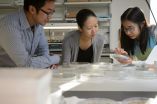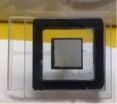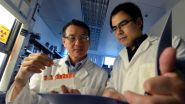INFORMATION:
Other researchers were Vikram Sathyendra, orthopaedics resident; Henry J. Donahue, professor of orthopaedics and rehabilitation; Kent E. Vrana, professor of pharmacology; Arthur Berg, associate professor of biostatistics and bioinformatics; David Fryzel, resident in general surgery; and Jonathan Gandhi, a member of the Penn State College of Medicine class of 2013.
The Orthopaedic Trauma Association funded this study.
Common gene variants linked to delayed healing of bone fractures
2014-10-14
(Press-News.org) Slow-healing or non-healing bone fractures in otherwise healthy people may be caused by gene variants that are common in the population, according to Penn State College of Medicine researchers.
"We found associations between certain gene polymorphisms and delayed fracture healing in a sample of patients," said J. Spence Reid, professor of orthopaedics and rehabilitation. "Our study was preliminary but it demonstrated the feasibility of a larger one, which we're now working to set up."
The identification of gene variants that delay fracture healing could lead to screening tests for patients with broken bones. Those patients deemed likely to experience slow healing could be given more aggressive treatment when they first reach the hospital, potentially avoiding months of debilitation.
The researchers reported their results in the Journal of Bone and Joint Surgery.
Of the eight million bone fractures in the U.S. every year, about 10 percent fail to heal normally. Smoking, diabetes, NSAID use, low vitamin D levels and old age are known risk factors, but in a significant subset of cases, unknown factors appear to be involved.
"Some fractures are slow-healing for no obvious reason, and we wondered if there is a genetic basis for those cases," said Reid.
He and his colleagues selected from their records 33 patients diagnosed with "atrophic nonunion" -- the failure of a fracture to knit together on its own within six months. As controls, they selected 29 patients whose fractures had healed normally.
Using cheek swabs, the researchers obtained DNA from the patients. In each case they checked tiny sites of known DNA-sequence variations -- "single nucleotide polymorphisms" -- that mark common gene variants. They looked only at the SNPs within 30 genes suspected of involvement in fracture healing.
The analysis revealed three SNPs that were more common in the non-healing group than in the normal-healing group -- hinting that their respective gene variants may somehow impair or fail to support fracture healing.
Two of these SNPs are within a single gene, which codes for the enzyme nitric oxide synthase 2 (NOS2). Prior studies showed that this enzyme is produced early in the fracture healing process, and that deletion of the NOS2 gene delays healing in mice.
The other SNP of interest lies within the gene for interleukin 1-Beta, a signaling molecule best known as a promoter of inflammation. Interleukin 1-Beta is suspected also to be an early orchestrator of the new bone growth that knits together a fracture.
The findings point to the possibility that common variants of NOS2 and interleukin 1-Beta have reduced function in support of fracture healing, and raise the risk of delayed healing. But Reid cautioned that the small patient sample and the small number of genes analyzed means that the results should be considered preliminary until a larger study is done.
The researchers are currently planning a study with a larger patient sample and a broader mapping of the genome, to provide a more definitive picture of the gene variants associated with delayed fracture healing.
In principle, identifying specific gene variants as risk factors for poor fracture healing would lead not only to the development of patient screening tests, but also to a better understanding of the basic biology of how fractures heal.
"We could develop mouse models of these genetic polymorphisms, for example, to observe in detail the role they play after a fracture," Reid said.
ELSE PRESS RELEASES FROM THIS DATE:
Precise control over genes results from game-changing research
2014-10-14
The application of a new, precise way to turn genes on and off within cells, described online October 9, 2014 in two articles in the journal Cell, is likely to lead to a better understanding of diseases and possibly to new therapies, according to UC San Francisco scientists.
The key to the advance is a new invention, called the SunTag, a series of molecular hooks for hanging multiple copies of biologically active molecules onto a single protein scaffold used to target genes or other molecules. Compared to molecules assembled without these hooks, those incorporating the ...
Discovery of cellular snooze button advances cancer and biofuel research
2014-10-14
EAST LANSING, Mich. – The discovery of a cellular snooze button has allowed a team of Michigan State University scientists to potentially improve biofuel production and offer insight on the early stages of cancer.
The discovery that the protein CHT7 is a likely repressor of cellular quiescence, or resting state, is published in the current issue of the Proceedings of the National Academy of Sciences. This cellular switch, which influences algae's growth and oil production, also wields control of cellular growth – and tumor growth – in humans.
Christoph ...
Sustained feedback to doctors may help maintain appropriate antibiotic usage in children
2014-10-14
A program that provides guidance to primary care physicians about appropriately prescribing antibiotics for children is effective, but its improvements wear off after regular auditing and feedback are discontinued.
"Our findings suggest that interventions with outpatient healthcare providers should include continued feedback to clinicians to remain effective," said study leader Jeffrey S. Gerber, M.D., Ph.D., an infectious diseases specialist at The Children's Hospital of Philadelphia (CHOP).
Gerber and colleagues from CHOP published their research online Oct. 10 in ...
Earliest-known lamprey larva fossils unearthed in Inner Mongolia
2014-10-14
LAWRENCE — Few people devote time to pondering the ancient origins of the eel-like lamprey, yet the evolutionary saga of the bloodsucker holds essential clues to the biological roots of humanity.
Today, the Proceedings of the National Academy of Sciences published a description of fossilized lamprey larvae that date back to the Lower Cretaceous — at least 65 million years ago.
They're the oldest identified fossils displaying the creature in stages of pre-metamorphosis and metamorphosis.
"Among animals with backbones, everything, including us, evolved from ...
Stress may be harder on women's hearts than men's
2014-10-14
DURHAM, N.C. -- Researchers have known for decades that stress contributes to heart disease. But a new analysis by researchers at Duke Medicine shows mental stress may tax women's hearts more than men's.
The research appears online Oct. 13, 2014, in the Journal of the American College of Cardiology.
"Normally when under stress, we fight back or run away. In order to do that, we need to pump more blood to the body," said Wei Jiang, M.D., the study's senior author and professor of medicine, psychiatry and behavioral sciences at the Duke University School of Medicine. ...
Beyond LEDs: Brighter, new energy-saving flat panel lights based on carbon nanotubes
2014-10-14
Washington D.C., October 14, 2014 -- Even as the 2014 Nobel Prize in Physics has enshrined light emitting diodes (LEDs) as the single most significant and disruptive energy-efficient lighting solution of today, scientists around the world continue unabated to search for the even-better-bulbs of tomorrow.
Enter carbon electronics.
Electronics based on carbon, especially carbon nanotubes (CNTs), are emerging as successors to silicon for making semiconductor materials. And they may enable a new generation of brighter, low-power, low-cost lighting devices that could challenge ...
Rats of New York and the diseases they carry
2014-10-14
In the first study to look at would-be diseases carried by New York City rats, scientists at the Center for Infection and Immunity at Columbia University's Mailman School of Public Health identified bacterial pathogens, including E. coli, Salmonella, and C. difficile, that cause mild to life-threatening gastroenteritis in people; Seoul hantavirus, which causes Ebola-like hemorrhagic fever and kidney failure in humans; and the closest relative to human hepatitis C. Results appear in the journal mBio.
The researchers trapped 133 Norway rats at 5 sites in New York City, ...
'Grapes of Wrath': Stomping out grape disease one vineyard at a time
2014-10-14
Cracking the genetic code of a common disease affecting grape production could improve vineyard management and help protect the multibillion-dollar industry that includes raisins, juice, jam/jelly, fresh grapes, grape-seed extract and oil, vinegar and wine.
A Rochester Institute of Technology scientist and an RIT alumnus are close to completing the genetic blueprint, or microbiome, of grape crown gall tumor disease—the bane of vineyards worldwide. Their study focuses on 16 grape varieties, including Cabernet Sauvignon and Riesling, from vineyards in the New York ...
Brand loyalty: What happens when our favorite products are unavailable?
2014-10-14
What would happen to all those millions of Snickers fans if their favorite chocolate bar was temporarily out of stock? Would they wait for it to be available again or would they quickly switch allegiance to Milky Way or Kit Kat? According to a new study in the Journal of Consumer Research, when you can't get your favorite product, you'll quickly forget about it if you can find a good replacement.
"We studied situations in which products are temporarily unavailable. We found that desire for a product depends on the amount of time that has passed since a consumer was able ...
New treatment target identified for aggressive breast cancer
2014-10-14
AUGUSTA, Ga. – One of the first-known oncogenes has a protein partner that helps breast cancer proliferate and when it's blocked, so is the cancer, scientists report.
The gene ErbB2, commonly called HER2, is highly expressed in about 25 percent of breast cancers. Scientists have now found the protein Erbin, thought to be an anti-tumor factor, also is highly expressed in these cancers and essential to ErbB2's support of breast cancer.
When scientists interfere with the interaction between the two in mice, it inhibits tumor development and the usual spread to the ...





